Recipe Modification and Analysis Assignment: Chicken Caesar Salad
VerifiedAdded on 2022/10/03
|16
|4726
|223
Homework Assignment
AI Summary
This assignment focuses on recipe modification and nutritional analysis. The student started with a Chicken Caesar Salad recipe, analyzed its nutritional content, and identified areas for improvement. The original recipe was high in calories, fat, and sodium. The student modified the recipe by substituting ingredients to increase fiber, reduce fat and sodium, and increase the vegetable content. The modified recipe used whole-wheat bread, baked chicken, steamed salmon, and low-fat dairy products. The student then re-analyzed the modified recipe, comparing the nutritional profiles and discussing how the changes could benefit health, specifically in the context of reducing the risk of heart disease, cancer, and diabetes. The student also considered the impact of lifestyle and dietary changes on overall health and wellness, emphasizing the importance of balanced eating and regular physical activity. The assignment concludes with a personal reflection on the changes and how the student plans to improve their diet.
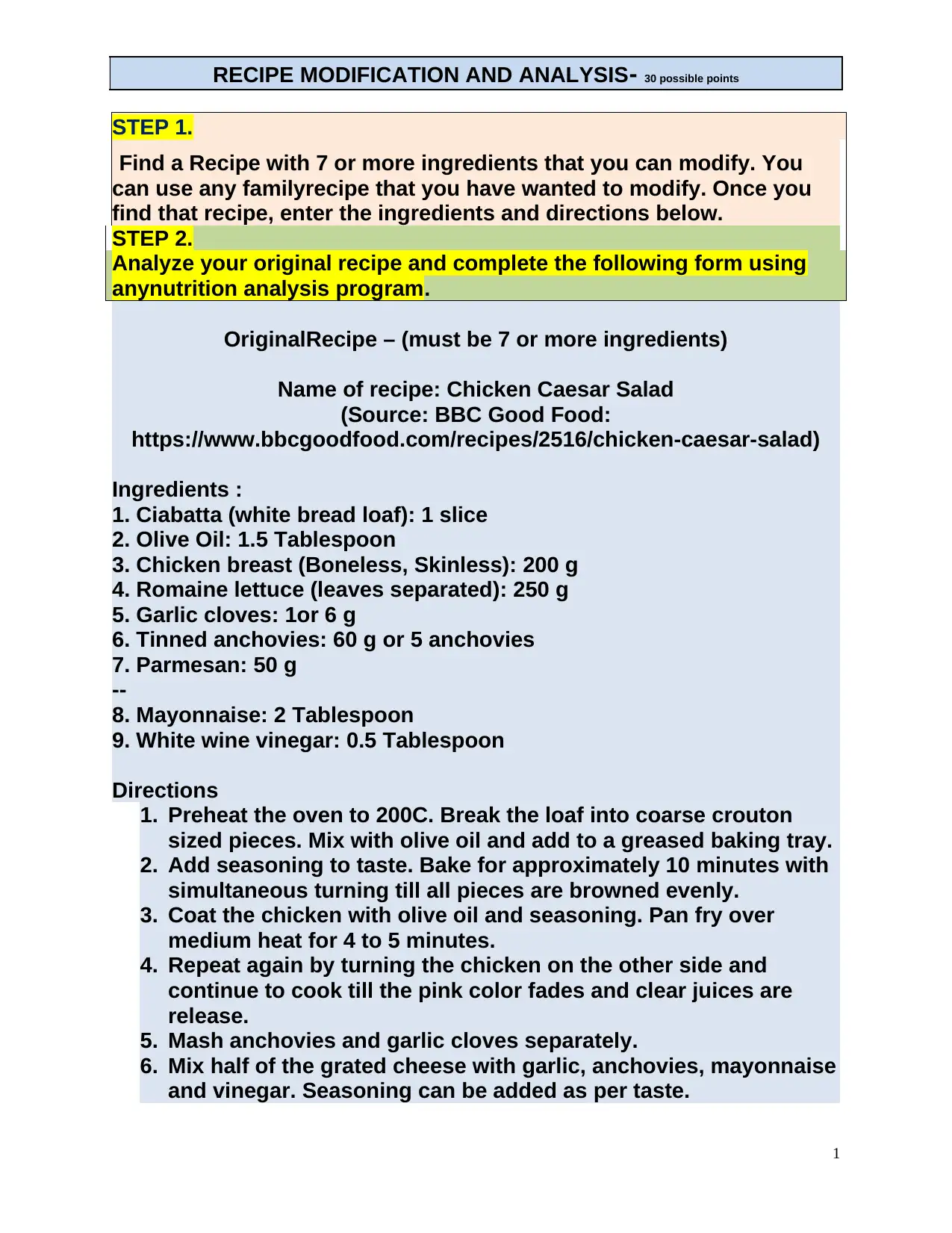
RECIPE MODIFICATION AND ANALYSIS- 30 possible points
STEP 1.
Find a Recipe with 7 or more ingredients that you can modify. You
can use any familyrecipe that you have wanted to modify. Once you
find that recipe, enter the ingredients and directions below.
STEP 2.
Analyze your original recipe and complete the following form using
anynutrition analysis program.
OriginalRecipe – (must be 7 or more ingredients)
Name of recipe: Chicken Caesar Salad
(Source: BBC Good Food:
https://www.bbcgoodfood.com/recipes/2516/chicken-caesar-salad)
Ingredients :
1. Ciabatta (white bread loaf): 1 slice
2. Olive Oil: 1.5 Tablespoon
3. Chicken breast (Boneless, Skinless): 200 g
4. Romaine lettuce (leaves separated): 250 g
5. Garlic cloves: 1or 6 g
6. Tinned anchovies: 60 g or 5 anchovies
7. Parmesan: 50 g
--
8. Mayonnaise: 2 Tablespoon
9. White wine vinegar: 0.5 Tablespoon
Directions
1. Preheat the oven to 200C. Break the loaf into coarse crouton
sized pieces. Mix with olive oil and add to a greased baking tray.
2. Add seasoning to taste. Bake for approximately 10 minutes with
simultaneous turning till all pieces are browned evenly.
3. Coat the chicken with olive oil and seasoning. Pan fry over
medium heat for 4 to 5 minutes.
4. Repeat again by turning the chicken on the other side and
continue to cook till the pink color fades and clear juices are
release.
5. Mash anchovies and garlic cloves separately.
6. Mix half of the grated cheese with garlic, anchovies, mayonnaise
and vinegar. Seasoning can be added as per taste.
1
STEP 1.
Find a Recipe with 7 or more ingredients that you can modify. You
can use any familyrecipe that you have wanted to modify. Once you
find that recipe, enter the ingredients and directions below.
STEP 2.
Analyze your original recipe and complete the following form using
anynutrition analysis program.
OriginalRecipe – (must be 7 or more ingredients)
Name of recipe: Chicken Caesar Salad
(Source: BBC Good Food:
https://www.bbcgoodfood.com/recipes/2516/chicken-caesar-salad)
Ingredients :
1. Ciabatta (white bread loaf): 1 slice
2. Olive Oil: 1.5 Tablespoon
3. Chicken breast (Boneless, Skinless): 200 g
4. Romaine lettuce (leaves separated): 250 g
5. Garlic cloves: 1or 6 g
6. Tinned anchovies: 60 g or 5 anchovies
7. Parmesan: 50 g
--
8. Mayonnaise: 2 Tablespoon
9. White wine vinegar: 0.5 Tablespoon
Directions
1. Preheat the oven to 200C. Break the loaf into coarse crouton
sized pieces. Mix with olive oil and add to a greased baking tray.
2. Add seasoning to taste. Bake for approximately 10 minutes with
simultaneous turning till all pieces are browned evenly.
3. Coat the chicken with olive oil and seasoning. Pan fry over
medium heat for 4 to 5 minutes.
4. Repeat again by turning the chicken on the other side and
continue to cook till the pink color fades and clear juices are
release.
5. Mash anchovies and garlic cloves separately.
6. Mix half of the grated cheese with garlic, anchovies, mayonnaise
and vinegar. Seasoning can be added as per taste.
1
Paraphrase This Document
Need a fresh take? Get an instant paraphrase of this document with our AI Paraphraser
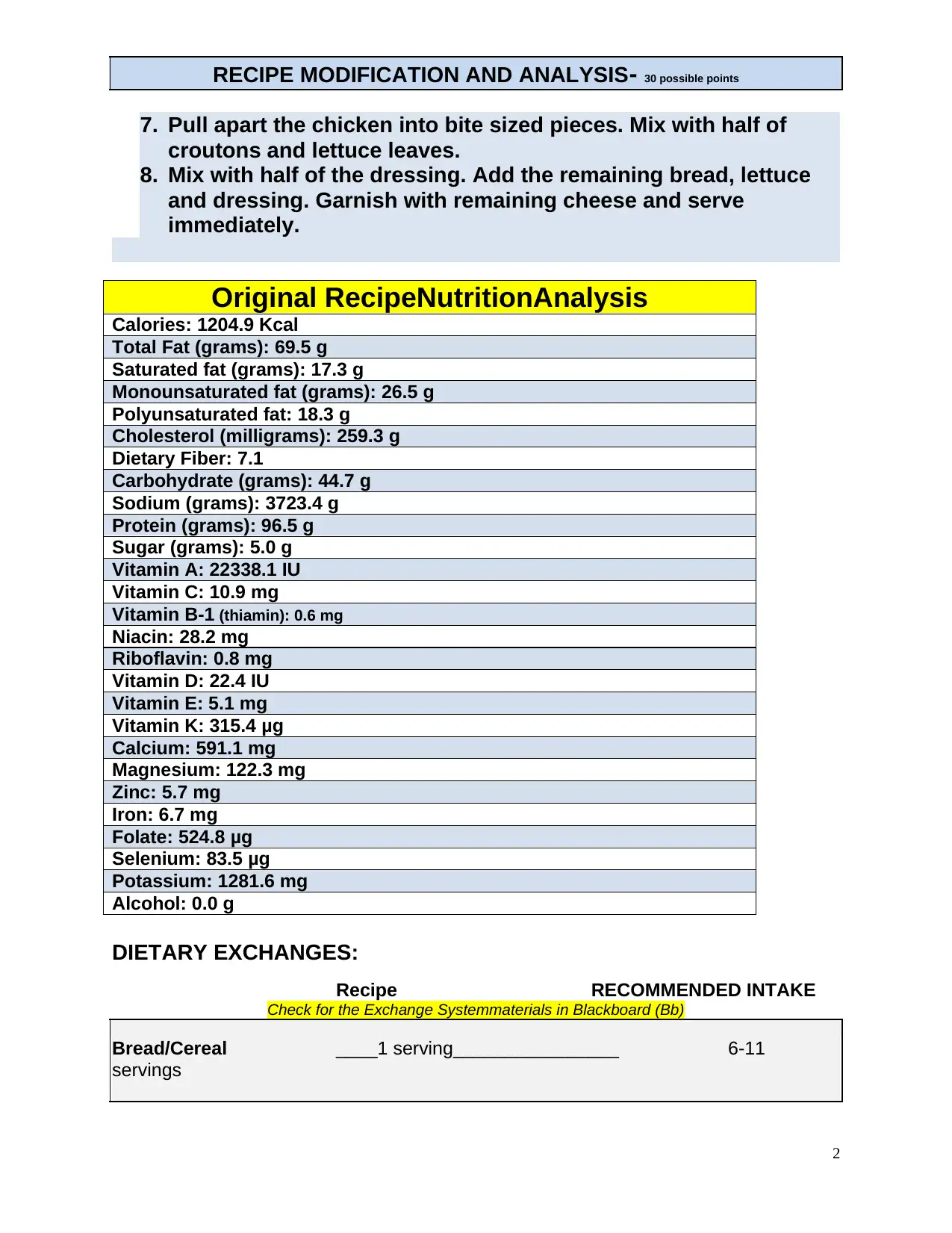
RECIPE MODIFICATION AND ANALYSIS- 30 possible points
7. Pull apart the chicken into bite sized pieces. Mix with half of
croutons and lettuce leaves.
8. Mix with half of the dressing. Add the remaining bread, lettuce
and dressing. Garnish with remaining cheese and serve
immediately.
Original RecipeNutritionAnalysis
Calories: 1204.9 Kcal
Total Fat (grams): 69.5 g
Saturated fat (grams): 17.3 g
Monounsaturated fat (grams): 26.5 g
Polyunsaturated fat: 18.3 g
Cholesterol (milligrams): 259.3 g
Dietary Fiber: 7.1
Carbohydrate (grams): 44.7 g
Sodium (grams): 3723.4 g
Protein (grams): 96.5 g
Sugar (grams): 5.0 g
Vitamin A: 22338.1 IU
Vitamin C: 10.9 mg
Vitamin B-1 (thiamin): 0.6 mg
Niacin: 28.2 mg
Riboflavin: 0.8 mg
Vitamin D: 22.4 IU
Vitamin E: 5.1 mg
Vitamin K: 315.4 μg
Calcium: 591.1 mg
Magnesium: 122.3 mg
Zinc: 5.7 mg
Iron: 6.7 mg
Folate: 524.8 μg
Selenium: 83.5 μg
Potassium: 1281.6 mg
Alcohol: 0.0 g
DIETARY EXCHANGES:
Recipe RECOMMENDED INTAKE
Check for the Exchange Systemmaterials in Blackboard (Bb)
Bread/Cereal ____1 serving________________ 6-11
servings
2
7. Pull apart the chicken into bite sized pieces. Mix with half of
croutons and lettuce leaves.
8. Mix with half of the dressing. Add the remaining bread, lettuce
and dressing. Garnish with remaining cheese and serve
immediately.
Original RecipeNutritionAnalysis
Calories: 1204.9 Kcal
Total Fat (grams): 69.5 g
Saturated fat (grams): 17.3 g
Monounsaturated fat (grams): 26.5 g
Polyunsaturated fat: 18.3 g
Cholesterol (milligrams): 259.3 g
Dietary Fiber: 7.1
Carbohydrate (grams): 44.7 g
Sodium (grams): 3723.4 g
Protein (grams): 96.5 g
Sugar (grams): 5.0 g
Vitamin A: 22338.1 IU
Vitamin C: 10.9 mg
Vitamin B-1 (thiamin): 0.6 mg
Niacin: 28.2 mg
Riboflavin: 0.8 mg
Vitamin D: 22.4 IU
Vitamin E: 5.1 mg
Vitamin K: 315.4 μg
Calcium: 591.1 mg
Magnesium: 122.3 mg
Zinc: 5.7 mg
Iron: 6.7 mg
Folate: 524.8 μg
Selenium: 83.5 μg
Potassium: 1281.6 mg
Alcohol: 0.0 g
DIETARY EXCHANGES:
Recipe RECOMMENDED INTAKE
Check for the Exchange Systemmaterials in Blackboard (Bb)
Bread/Cereal ____1 serving________________ 6-11
servings
2
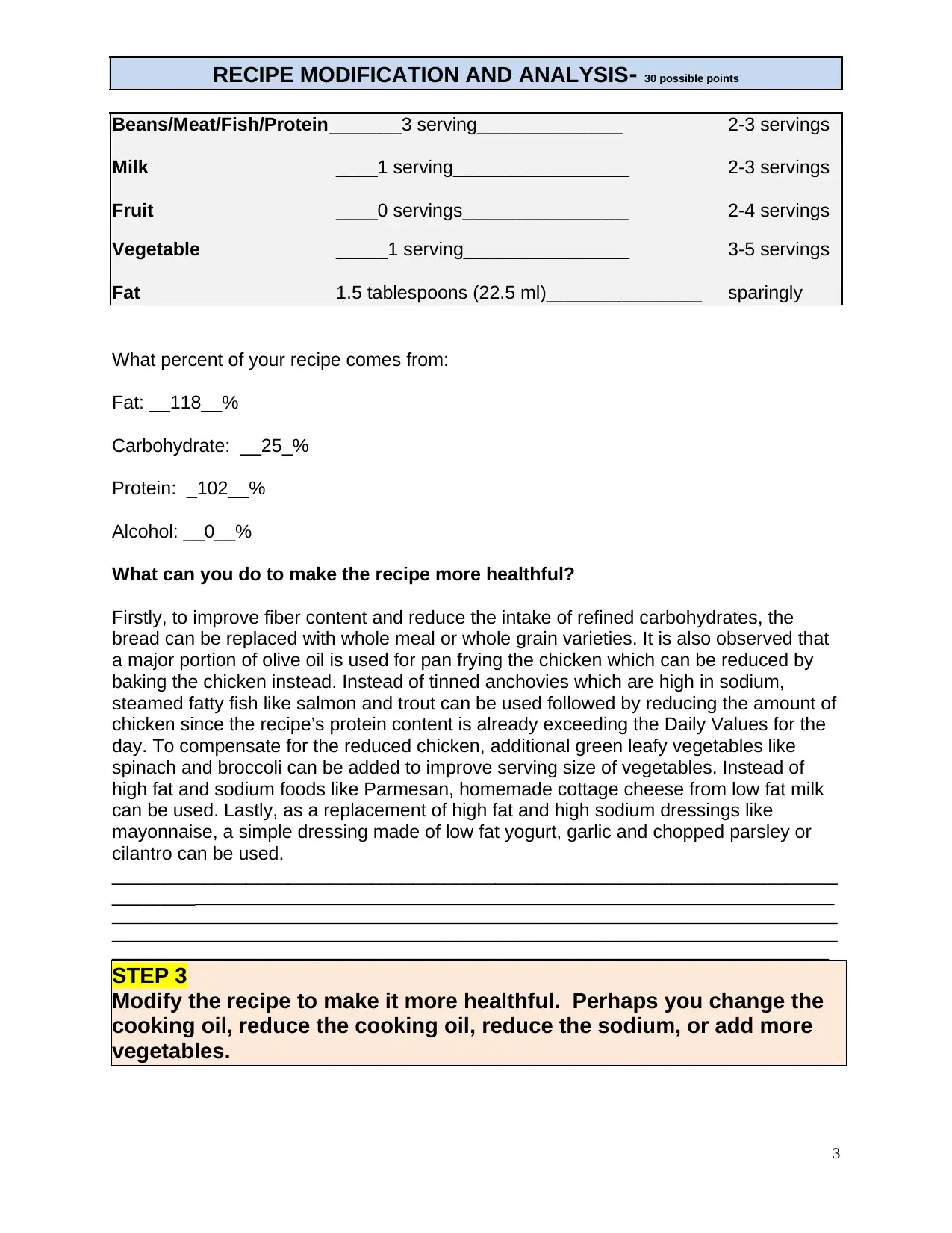
RECIPE MODIFICATION AND ANALYSIS- 30 possible points
Beans/Meat/Fish/Protein_______3 serving______________ 2-3 servings
Milk ____1 serving_________________ 2-3 servings
Fruit ____0 servings________________ 2-4 servings
Vegetable _____1 serving________________ 3-5 servings
Fat 1.5 tablespoons (22.5 ml)_______________ sparingly
What percent of your recipe comes from:
Fat: __118__%
Carbohydrate: __25_%
Protein: _102__%
Alcohol: __0__%
What can you do to make the recipe more healthful?
Firstly, to improve fiber content and reduce the intake of refined carbohydrates, the
bread can be replaced with whole meal or whole grain varieties. It is also observed that
a major portion of olive oil is used for pan frying the chicken which can be reduced by
baking the chicken instead. Instead of tinned anchovies which are high in sodium,
steamed fatty fish like salmon and trout can be used followed by reducing the amount of
chicken since the recipe’s protein content is already exceeding the Daily Values for the
day. To compensate for the reduced chicken, additional green leafy vegetables like
spinach and broccoli can be added to improve serving size of vegetables. Instead of
high fat and sodium foods like Parmesan, homemade cottage cheese from low fat milk
can be used. Lastly, as a replacement of high fat and high sodium dressings like
mayonnaise, a simple dressing made of low fat yogurt, garlic and chopped parsley or
cilantro can be used.
______________________________________________________________________
__________________________________________________________________________________
____________________________________________________________________________________
____________________________________________________________________________________
___________________________________________________________________________________
STEP 3
Modify the recipe to make it more healthful. Perhaps you change the
cooking oil, reduce the cooking oil, reduce the sodium, or add more
vegetables.
3
Beans/Meat/Fish/Protein_______3 serving______________ 2-3 servings
Milk ____1 serving_________________ 2-3 servings
Fruit ____0 servings________________ 2-4 servings
Vegetable _____1 serving________________ 3-5 servings
Fat 1.5 tablespoons (22.5 ml)_______________ sparingly
What percent of your recipe comes from:
Fat: __118__%
Carbohydrate: __25_%
Protein: _102__%
Alcohol: __0__%
What can you do to make the recipe more healthful?
Firstly, to improve fiber content and reduce the intake of refined carbohydrates, the
bread can be replaced with whole meal or whole grain varieties. It is also observed that
a major portion of olive oil is used for pan frying the chicken which can be reduced by
baking the chicken instead. Instead of tinned anchovies which are high in sodium,
steamed fatty fish like salmon and trout can be used followed by reducing the amount of
chicken since the recipe’s protein content is already exceeding the Daily Values for the
day. To compensate for the reduced chicken, additional green leafy vegetables like
spinach and broccoli can be added to improve serving size of vegetables. Instead of
high fat and sodium foods like Parmesan, homemade cottage cheese from low fat milk
can be used. Lastly, as a replacement of high fat and high sodium dressings like
mayonnaise, a simple dressing made of low fat yogurt, garlic and chopped parsley or
cilantro can be used.
______________________________________________________________________
__________________________________________________________________________________
____________________________________________________________________________________
____________________________________________________________________________________
___________________________________________________________________________________
STEP 3
Modify the recipe to make it more healthful. Perhaps you change the
cooking oil, reduce the cooking oil, reduce the sodium, or add more
vegetables.
3
⊘ This is a preview!⊘
Do you want full access?
Subscribe today to unlock all pages.

Trusted by 1+ million students worldwide
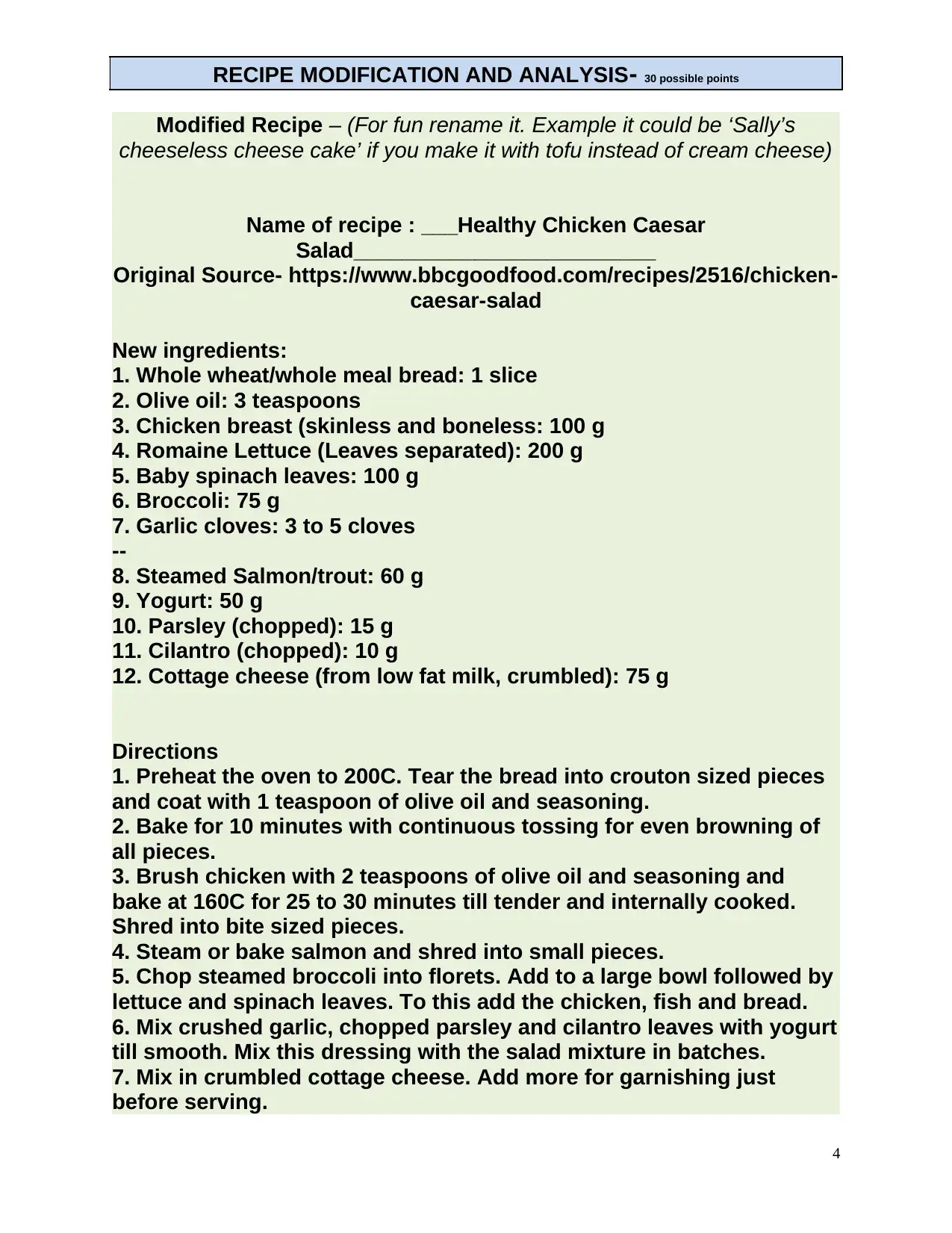
RECIPE MODIFICATION AND ANALYSIS- 30 possible points
Modified Recipe – (For fun rename it. Example it could be ‘Sally’s
cheeseless cheese cake’ if you make it with tofu instead of cream cheese)
Name of recipe : ___Healthy Chicken Caesar
Salad_________________________
Original Source- https://www.bbcgoodfood.com/recipes/2516/chicken-
caesar-salad
New ingredients:
1. Whole wheat/whole meal bread: 1 slice
2. Olive oil: 3 teaspoons
3. Chicken breast (skinless and boneless: 100 g
4. Romaine Lettuce (Leaves separated): 200 g
5. Baby spinach leaves: 100 g
6. Broccoli: 75 g
7. Garlic cloves: 3 to 5 cloves
--
8. Steamed Salmon/trout: 60 g
9. Yogurt: 50 g
10. Parsley (chopped): 15 g
11. Cilantro (chopped): 10 g
12. Cottage cheese (from low fat milk, crumbled): 75 g
Directions
1. Preheat the oven to 200C. Tear the bread into crouton sized pieces
and coat with 1 teaspoon of olive oil and seasoning.
2. Bake for 10 minutes with continuous tossing for even browning of
all pieces.
3. Brush chicken with 2 teaspoons of olive oil and seasoning and
bake at 160C for 25 to 30 minutes till tender and internally cooked.
Shred into bite sized pieces.
4. Steam or bake salmon and shred into small pieces.
5. Chop steamed broccoli into florets. Add to a large bowl followed by
lettuce and spinach leaves. To this add the chicken, fish and bread.
6. Mix crushed garlic, chopped parsley and cilantro leaves with yogurt
till smooth. Mix this dressing with the salad mixture in batches.
7. Mix in crumbled cottage cheese. Add more for garnishing just
before serving.
4
Modified Recipe – (For fun rename it. Example it could be ‘Sally’s
cheeseless cheese cake’ if you make it with tofu instead of cream cheese)
Name of recipe : ___Healthy Chicken Caesar
Salad_________________________
Original Source- https://www.bbcgoodfood.com/recipes/2516/chicken-
caesar-salad
New ingredients:
1. Whole wheat/whole meal bread: 1 slice
2. Olive oil: 3 teaspoons
3. Chicken breast (skinless and boneless: 100 g
4. Romaine Lettuce (Leaves separated): 200 g
5. Baby spinach leaves: 100 g
6. Broccoli: 75 g
7. Garlic cloves: 3 to 5 cloves
--
8. Steamed Salmon/trout: 60 g
9. Yogurt: 50 g
10. Parsley (chopped): 15 g
11. Cilantro (chopped): 10 g
12. Cottage cheese (from low fat milk, crumbled): 75 g
Directions
1. Preheat the oven to 200C. Tear the bread into crouton sized pieces
and coat with 1 teaspoon of olive oil and seasoning.
2. Bake for 10 minutes with continuous tossing for even browning of
all pieces.
3. Brush chicken with 2 teaspoons of olive oil and seasoning and
bake at 160C for 25 to 30 minutes till tender and internally cooked.
Shred into bite sized pieces.
4. Steam or bake salmon and shred into small pieces.
5. Chop steamed broccoli into florets. Add to a large bowl followed by
lettuce and spinach leaves. To this add the chicken, fish and bread.
6. Mix crushed garlic, chopped parsley and cilantro leaves with yogurt
till smooth. Mix this dressing with the salad mixture in batches.
7. Mix in crumbled cottage cheese. Add more for garnishing just
before serving.
4
Paraphrase This Document
Need a fresh take? Get an instant paraphrase of this document with our AI Paraphraser
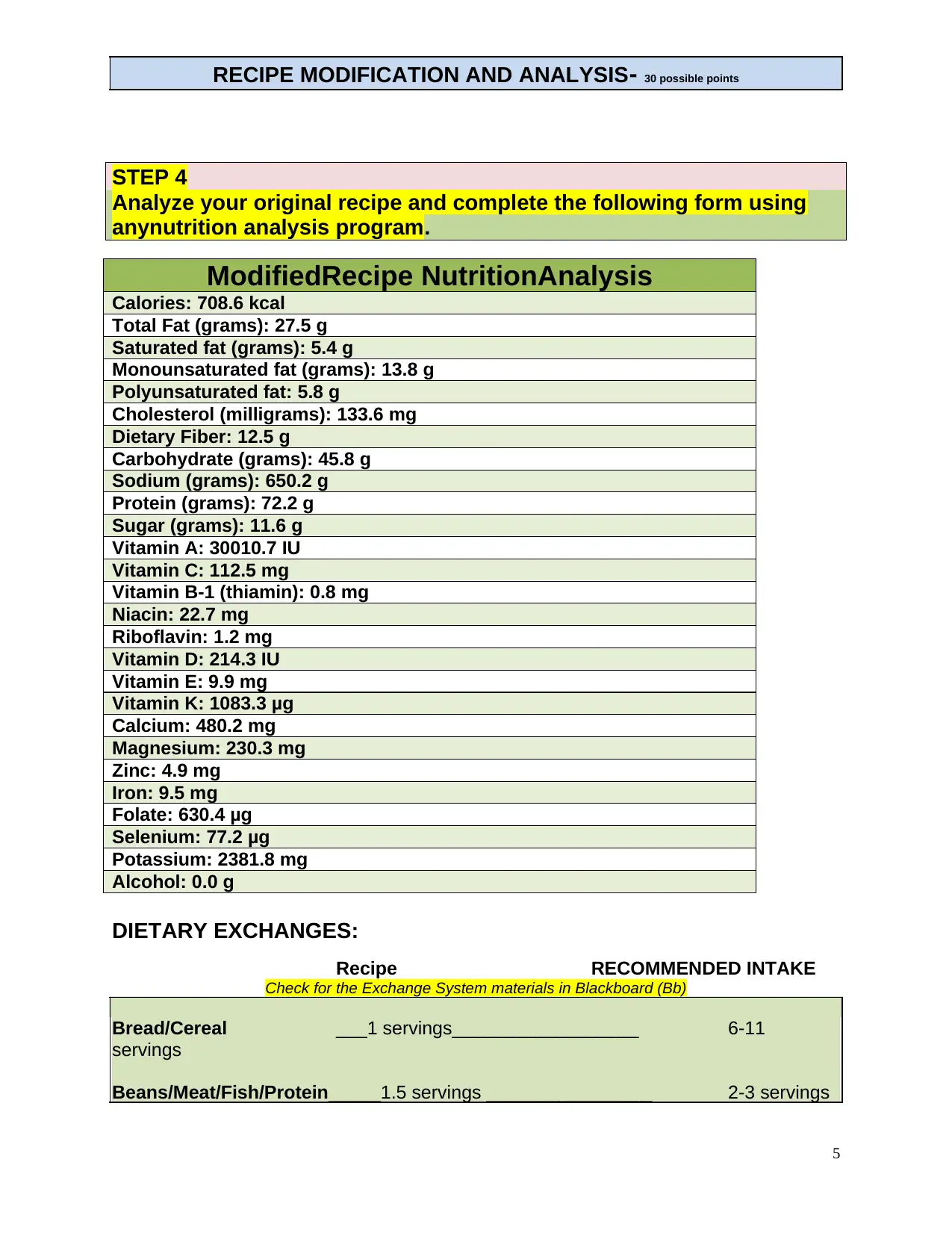
RECIPE MODIFICATION AND ANALYSIS- 30 possible points
STEP 4
Analyze your original recipe and complete the following form using
anynutrition analysis program.
ModifiedRecipe NutritionAnalysis
Calories: 708.6 kcal
Total Fat (grams): 27.5 g
Saturated fat (grams): 5.4 g
Monounsaturated fat (grams): 13.8 g
Polyunsaturated fat: 5.8 g
Cholesterol (milligrams): 133.6 mg
Dietary Fiber: 12.5 g
Carbohydrate (grams): 45.8 g
Sodium (grams): 650.2 g
Protein (grams): 72.2 g
Sugar (grams): 11.6 g
Vitamin A: 30010.7 IU
Vitamin C: 112.5 mg
Vitamin B-1 (thiamin): 0.8 mg
Niacin: 22.7 mg
Riboflavin: 1.2 mg
Vitamin D: 214.3 IU
Vitamin E: 9.9 mg
Vitamin K: 1083.3 μg
Calcium: 480.2 mg
Magnesium: 230.3 mg
Zinc: 4.9 mg
Iron: 9.5 mg
Folate: 630.4 μg
Selenium: 77.2 μg
Potassium: 2381.8 mg
Alcohol: 0.0 g
DIETARY EXCHANGES:
Recipe RECOMMENDED INTAKE
Check for the Exchange System materials in Blackboard (Bb)
Bread/Cereal ___1 servings__________________ 6-11
servings
Beans/Meat/Fish/Protein_____1.5 servings ________________ 2-3 servings
5
STEP 4
Analyze your original recipe and complete the following form using
anynutrition analysis program.
ModifiedRecipe NutritionAnalysis
Calories: 708.6 kcal
Total Fat (grams): 27.5 g
Saturated fat (grams): 5.4 g
Monounsaturated fat (grams): 13.8 g
Polyunsaturated fat: 5.8 g
Cholesterol (milligrams): 133.6 mg
Dietary Fiber: 12.5 g
Carbohydrate (grams): 45.8 g
Sodium (grams): 650.2 g
Protein (grams): 72.2 g
Sugar (grams): 11.6 g
Vitamin A: 30010.7 IU
Vitamin C: 112.5 mg
Vitamin B-1 (thiamin): 0.8 mg
Niacin: 22.7 mg
Riboflavin: 1.2 mg
Vitamin D: 214.3 IU
Vitamin E: 9.9 mg
Vitamin K: 1083.3 μg
Calcium: 480.2 mg
Magnesium: 230.3 mg
Zinc: 4.9 mg
Iron: 9.5 mg
Folate: 630.4 μg
Selenium: 77.2 μg
Potassium: 2381.8 mg
Alcohol: 0.0 g
DIETARY EXCHANGES:
Recipe RECOMMENDED INTAKE
Check for the Exchange System materials in Blackboard (Bb)
Bread/Cereal ___1 servings__________________ 6-11
servings
Beans/Meat/Fish/Protein_____1.5 servings ________________ 2-3 servings
5
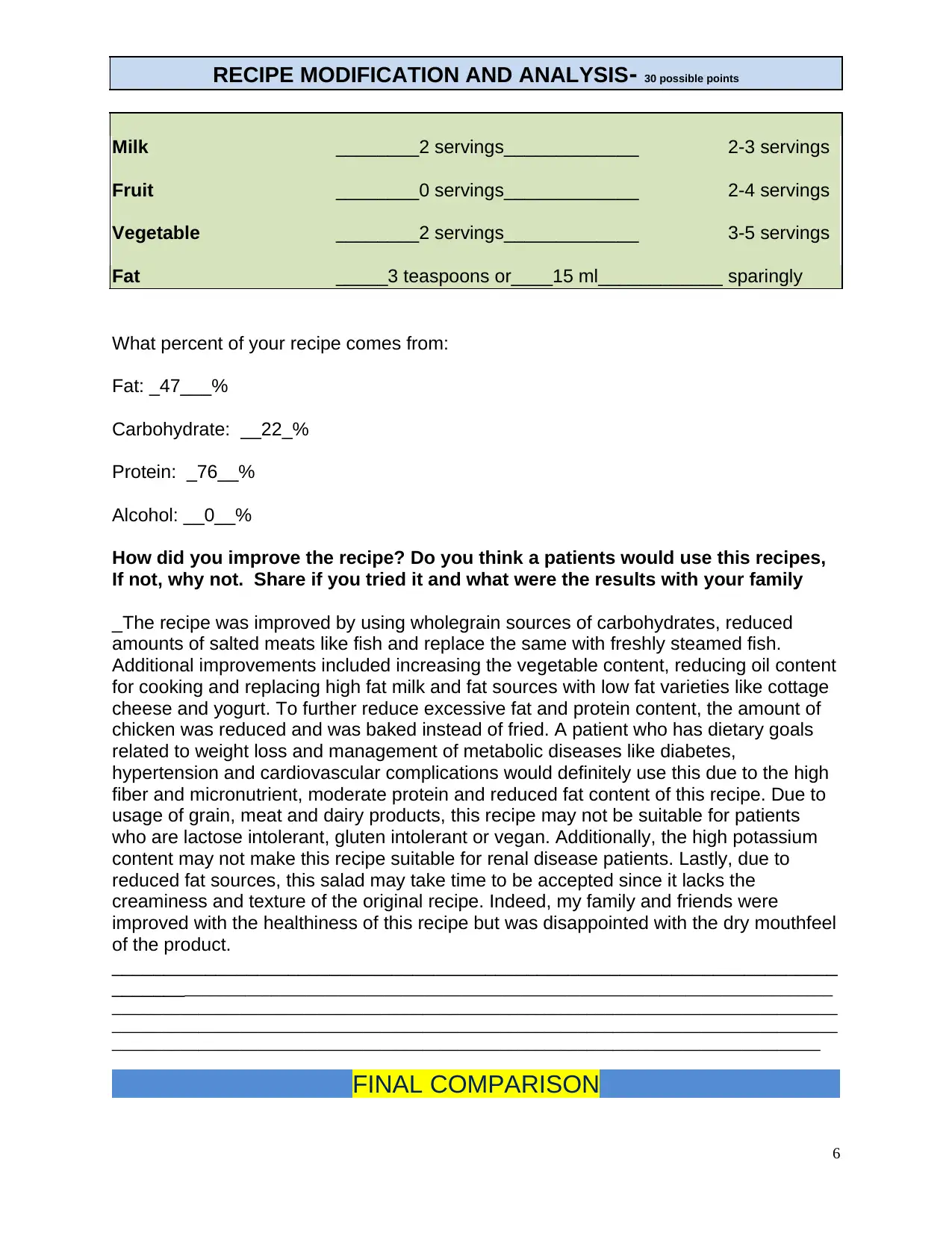
RECIPE MODIFICATION AND ANALYSIS- 30 possible points
Milk ________2 servings_____________ 2-3 servings
Fruit ________0 servings_____________ 2-4 servings
Vegetable ________2 servings_____________ 3-5 servings
Fat _____3 teaspoons or____15 ml____________ sparingly
What percent of your recipe comes from:
Fat: _47___%
Carbohydrate: __22_%
Protein: _76__%
Alcohol: __0__%
How did you improve the recipe? Do you think a patients would use this recipes,
If not, why not. Share if you tried it and what were the results with your family
_The recipe was improved by using wholegrain sources of carbohydrates, reduced
amounts of salted meats like fish and replace the same with freshly steamed fish.
Additional improvements included increasing the vegetable content, reducing oil content
for cooking and replacing high fat milk and fat sources with low fat varieties like cottage
cheese and yogurt. To further reduce excessive fat and protein content, the amount of
chicken was reduced and was baked instead of fried. A patient who has dietary goals
related to weight loss and management of metabolic diseases like diabetes,
hypertension and cardiovascular complications would definitely use this due to the high
fiber and micronutrient, moderate protein and reduced fat content of this recipe. Due to
usage of grain, meat and dairy products, this recipe may not be suitable for patients
who are lactose intolerant, gluten intolerant or vegan. Additionally, the high potassium
content may not make this recipe suitable for renal disease patients. Lastly, due to
reduced fat sources, this salad may take time to be accepted since it lacks the
creaminess and texture of the original recipe. Indeed, my family and friends were
improved with the healthiness of this recipe but was disappointed with the dry mouthfeel
of the product.
______________________________________________________________________
__________________________________________________________________________________
____________________________________________________________________________________
____________________________________________________________________________________
__________________________________________________________________________________
FINAL COMPARISON
6
Milk ________2 servings_____________ 2-3 servings
Fruit ________0 servings_____________ 2-4 servings
Vegetable ________2 servings_____________ 3-5 servings
Fat _____3 teaspoons or____15 ml____________ sparingly
What percent of your recipe comes from:
Fat: _47___%
Carbohydrate: __22_%
Protein: _76__%
Alcohol: __0__%
How did you improve the recipe? Do you think a patients would use this recipes,
If not, why not. Share if you tried it and what were the results with your family
_The recipe was improved by using wholegrain sources of carbohydrates, reduced
amounts of salted meats like fish and replace the same with freshly steamed fish.
Additional improvements included increasing the vegetable content, reducing oil content
for cooking and replacing high fat milk and fat sources with low fat varieties like cottage
cheese and yogurt. To further reduce excessive fat and protein content, the amount of
chicken was reduced and was baked instead of fried. A patient who has dietary goals
related to weight loss and management of metabolic diseases like diabetes,
hypertension and cardiovascular complications would definitely use this due to the high
fiber and micronutrient, moderate protein and reduced fat content of this recipe. Due to
usage of grain, meat and dairy products, this recipe may not be suitable for patients
who are lactose intolerant, gluten intolerant or vegan. Additionally, the high potassium
content may not make this recipe suitable for renal disease patients. Lastly, due to
reduced fat sources, this salad may take time to be accepted since it lacks the
creaminess and texture of the original recipe. Indeed, my family and friends were
improved with the healthiness of this recipe but was disappointed with the dry mouthfeel
of the product.
______________________________________________________________________
__________________________________________________________________________________
____________________________________________________________________________________
____________________________________________________________________________________
__________________________________________________________________________________
FINAL COMPARISON
6
⊘ This is a preview!⊘
Do you want full access?
Subscribe today to unlock all pages.

Trusted by 1+ million students worldwide
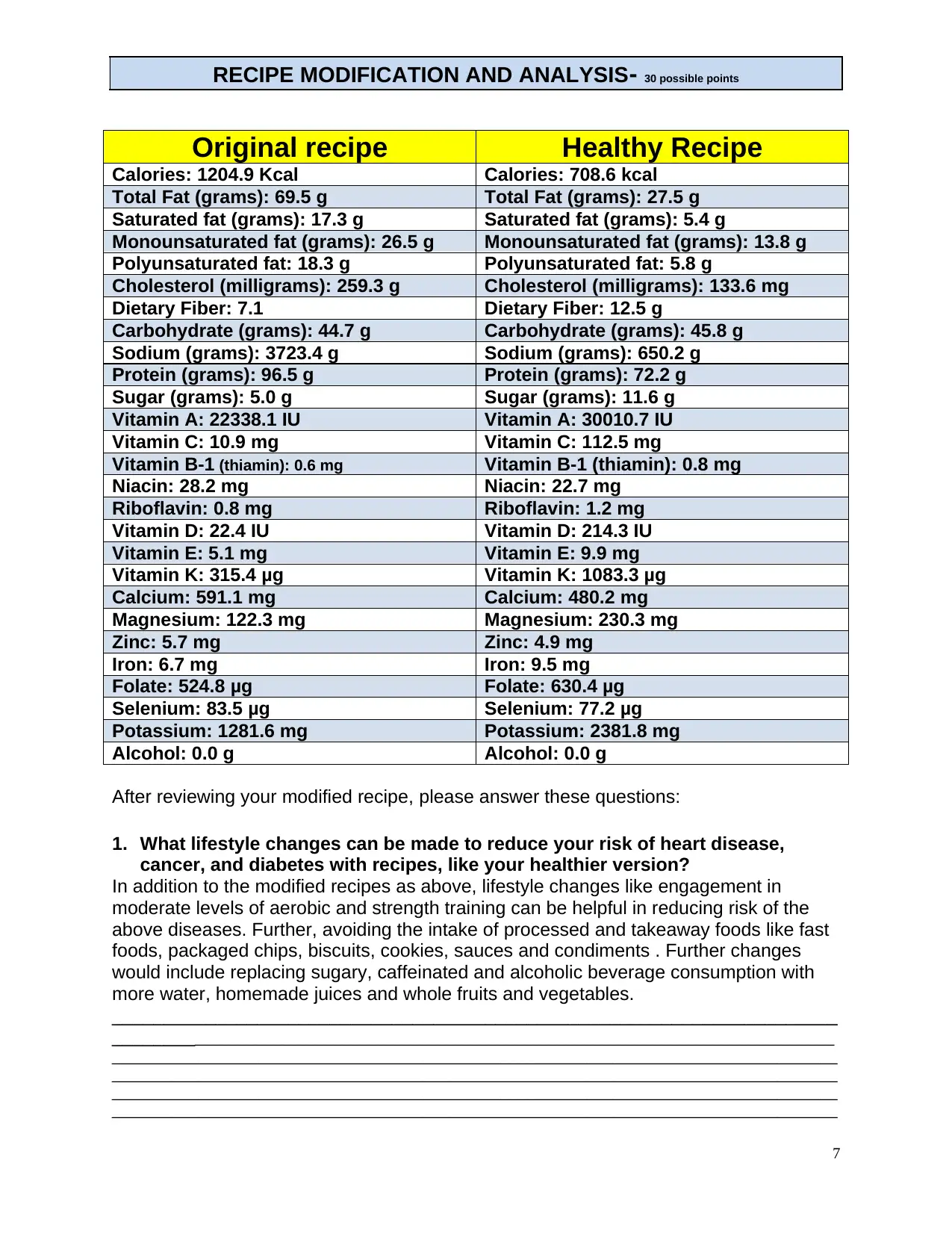
RECIPE MODIFICATION AND ANALYSIS- 30 possible points
Original recipe Healthy Recipe
Calories: 1204.9 Kcal Calories: 708.6 kcal
Total Fat (grams): 69.5 g Total Fat (grams): 27.5 g
Saturated fat (grams): 17.3 g Saturated fat (grams): 5.4 g
Monounsaturated fat (grams): 26.5 g Monounsaturated fat (grams): 13.8 g
Polyunsaturated fat: 18.3 g Polyunsaturated fat: 5.8 g
Cholesterol (milligrams): 259.3 g Cholesterol (milligrams): 133.6 mg
Dietary Fiber: 7.1 Dietary Fiber: 12.5 g
Carbohydrate (grams): 44.7 g Carbohydrate (grams): 45.8 g
Sodium (grams): 3723.4 g Sodium (grams): 650.2 g
Protein (grams): 96.5 g Protein (grams): 72.2 g
Sugar (grams): 5.0 g Sugar (grams): 11.6 g
Vitamin A: 22338.1 IU Vitamin A: 30010.7 IU
Vitamin C: 10.9 mg Vitamin C: 112.5 mg
Vitamin B-1 (thiamin): 0.6 mg Vitamin B-1 (thiamin): 0.8 mg
Niacin: 28.2 mg Niacin: 22.7 mg
Riboflavin: 0.8 mg Riboflavin: 1.2 mg
Vitamin D: 22.4 IU Vitamin D: 214.3 IU
Vitamin E: 5.1 mg Vitamin E: 9.9 mg
Vitamin K: 315.4 μg Vitamin K: 1083.3 μg
Calcium: 591.1 mg Calcium: 480.2 mg
Magnesium: 122.3 mg Magnesium: 230.3 mg
Zinc: 5.7 mg Zinc: 4.9 mg
Iron: 6.7 mg Iron: 9.5 mg
Folate: 524.8 μg Folate: 630.4 μg
Selenium: 83.5 μg Selenium: 77.2 μg
Potassium: 1281.6 mg Potassium: 2381.8 mg
Alcohol: 0.0 g Alcohol: 0.0 g
After reviewing your modified recipe, please answer these questions:
1. What lifestyle changes can be made to reduce your risk of heart disease,
cancer, and diabetes with recipes, like your healthier version?
In addition to the modified recipes as above, lifestyle changes like engagement in
moderate levels of aerobic and strength training can be helpful in reducing risk of the
above diseases. Further, avoiding the intake of processed and takeaway foods like fast
foods, packaged chips, biscuits, cookies, sauces and condiments . Further changes
would include replacing sugary, caffeinated and alcoholic beverage consumption with
more water, homemade juices and whole fruits and vegetables.
______________________________________________________________________
__________________________________________________________________________________
____________________________________________________________________________________
____________________________________________________________________________________
____________________________________________________________________________________
____________________________________________________________________________________
7
Original recipe Healthy Recipe
Calories: 1204.9 Kcal Calories: 708.6 kcal
Total Fat (grams): 69.5 g Total Fat (grams): 27.5 g
Saturated fat (grams): 17.3 g Saturated fat (grams): 5.4 g
Monounsaturated fat (grams): 26.5 g Monounsaturated fat (grams): 13.8 g
Polyunsaturated fat: 18.3 g Polyunsaturated fat: 5.8 g
Cholesterol (milligrams): 259.3 g Cholesterol (milligrams): 133.6 mg
Dietary Fiber: 7.1 Dietary Fiber: 12.5 g
Carbohydrate (grams): 44.7 g Carbohydrate (grams): 45.8 g
Sodium (grams): 3723.4 g Sodium (grams): 650.2 g
Protein (grams): 96.5 g Protein (grams): 72.2 g
Sugar (grams): 5.0 g Sugar (grams): 11.6 g
Vitamin A: 22338.1 IU Vitamin A: 30010.7 IU
Vitamin C: 10.9 mg Vitamin C: 112.5 mg
Vitamin B-1 (thiamin): 0.6 mg Vitamin B-1 (thiamin): 0.8 mg
Niacin: 28.2 mg Niacin: 22.7 mg
Riboflavin: 0.8 mg Riboflavin: 1.2 mg
Vitamin D: 22.4 IU Vitamin D: 214.3 IU
Vitamin E: 5.1 mg Vitamin E: 9.9 mg
Vitamin K: 315.4 μg Vitamin K: 1083.3 μg
Calcium: 591.1 mg Calcium: 480.2 mg
Magnesium: 122.3 mg Magnesium: 230.3 mg
Zinc: 5.7 mg Zinc: 4.9 mg
Iron: 6.7 mg Iron: 9.5 mg
Folate: 524.8 μg Folate: 630.4 μg
Selenium: 83.5 μg Selenium: 77.2 μg
Potassium: 1281.6 mg Potassium: 2381.8 mg
Alcohol: 0.0 g Alcohol: 0.0 g
After reviewing your modified recipe, please answer these questions:
1. What lifestyle changes can be made to reduce your risk of heart disease,
cancer, and diabetes with recipes, like your healthier version?
In addition to the modified recipes as above, lifestyle changes like engagement in
moderate levels of aerobic and strength training can be helpful in reducing risk of the
above diseases. Further, avoiding the intake of processed and takeaway foods like fast
foods, packaged chips, biscuits, cookies, sauces and condiments . Further changes
would include replacing sugary, caffeinated and alcoholic beverage consumption with
more water, homemade juices and whole fruits and vegetables.
______________________________________________________________________
__________________________________________________________________________________
____________________________________________________________________________________
____________________________________________________________________________________
____________________________________________________________________________________
____________________________________________________________________________________
7
Paraphrase This Document
Need a fresh take? Get an instant paraphrase of this document with our AI Paraphraser
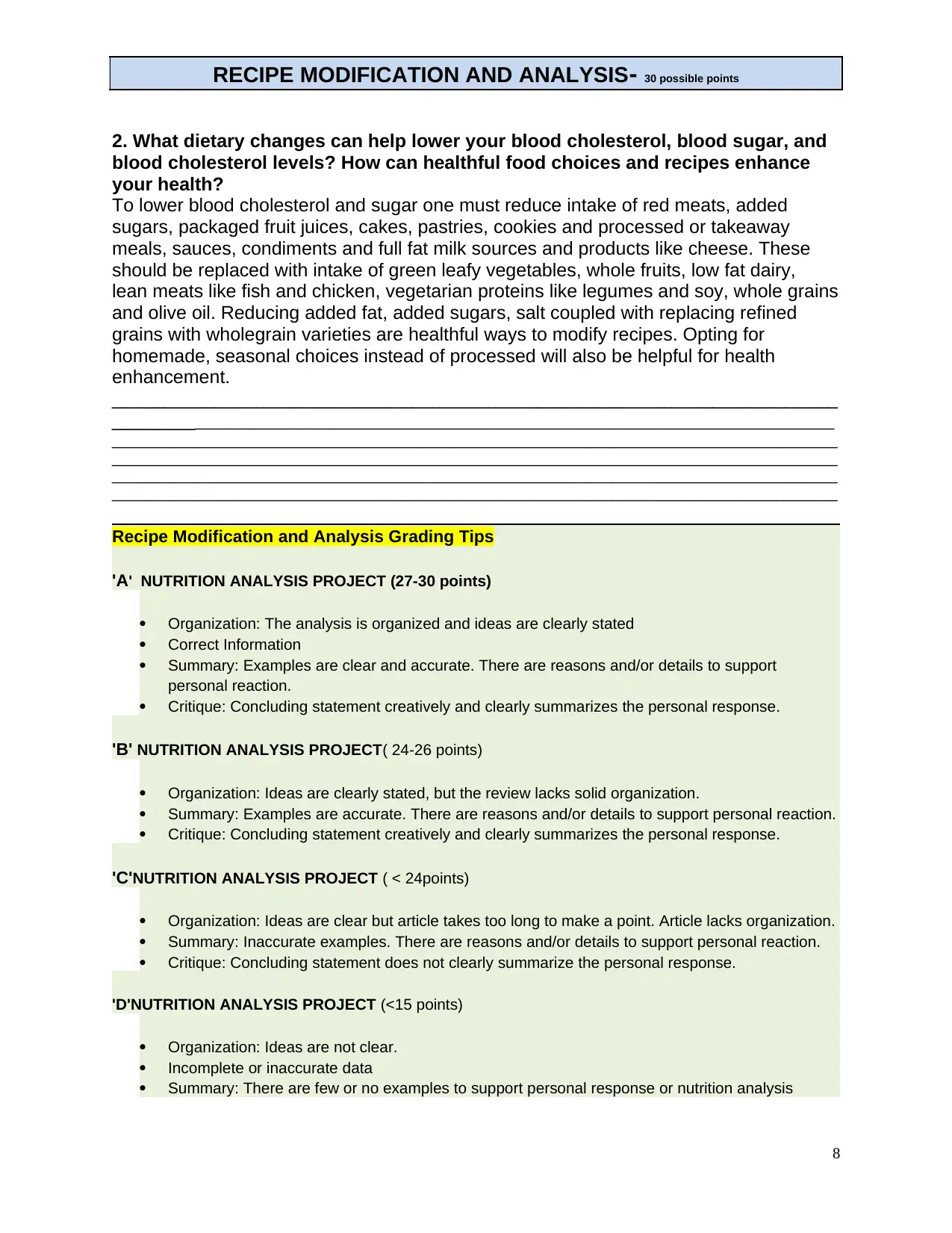
RECIPE MODIFICATION AND ANALYSIS- 30 possible points
2. What dietary changes can help lower your blood cholesterol, blood sugar, and
blood cholesterol levels? How can healthful food choices and recipes enhance
your health?
To lower blood cholesterol and sugar one must reduce intake of red meats, added
sugars, packaged fruit juices, cakes, pastries, cookies and processed or takeaway
meals, sauces, condiments and full fat milk sources and products like cheese. These
should be replaced with intake of green leafy vegetables, whole fruits, low fat dairy,
lean meats like fish and chicken, vegetarian proteins like legumes and soy, whole grains
and olive oil. Reducing added fat, added sugars, salt coupled with replacing refined
grains with wholegrain varieties are healthful ways to modify recipes. Opting for
homemade, seasonal choices instead of processed will also be helpful for health
enhancement.
______________________________________________________________________
__________________________________________________________________________________
____________________________________________________________________________________
____________________________________________________________________________________
____________________________________________________________________________________
____________________________________________________________________________________
Recipe Modification and Analysis Grading Tips
'A' NUTRITION ANALYSIS PROJECT (27-30 points)
Organization: The analysis is organized and ideas are clearly stated
Correct Information
Summary: Examples are clear and accurate. There are reasons and/or details to support
personal reaction.
Critique: Concluding statement creatively and clearly summarizes the personal response.
'B' NUTRITION ANALYSIS PROJECT( 24-26 points)
Organization: Ideas are clearly stated, but the review lacks solid organization.
Summary: Examples are accurate. There are reasons and/or details to support personal reaction.
Critique: Concluding statement creatively and clearly summarizes the personal response.
'C'NUTRITION ANALYSIS PROJECT ( < 24points)
Organization: Ideas are clear but article takes too long to make a point. Article lacks organization.
Summary: Inaccurate examples. There are reasons and/or details to support personal reaction.
Critique: Concluding statement does not clearly summarize the personal response.
'D'NUTRITION ANALYSIS PROJECT (<15 points)
Organization: Ideas are not clear.
Incomplete or inaccurate data
Summary: There are few or no examples to support personal response or nutrition analysis
8
2. What dietary changes can help lower your blood cholesterol, blood sugar, and
blood cholesterol levels? How can healthful food choices and recipes enhance
your health?
To lower blood cholesterol and sugar one must reduce intake of red meats, added
sugars, packaged fruit juices, cakes, pastries, cookies and processed or takeaway
meals, sauces, condiments and full fat milk sources and products like cheese. These
should be replaced with intake of green leafy vegetables, whole fruits, low fat dairy,
lean meats like fish and chicken, vegetarian proteins like legumes and soy, whole grains
and olive oil. Reducing added fat, added sugars, salt coupled with replacing refined
grains with wholegrain varieties are healthful ways to modify recipes. Opting for
homemade, seasonal choices instead of processed will also be helpful for health
enhancement.
______________________________________________________________________
__________________________________________________________________________________
____________________________________________________________________________________
____________________________________________________________________________________
____________________________________________________________________________________
____________________________________________________________________________________
Recipe Modification and Analysis Grading Tips
'A' NUTRITION ANALYSIS PROJECT (27-30 points)
Organization: The analysis is organized and ideas are clearly stated
Correct Information
Summary: Examples are clear and accurate. There are reasons and/or details to support
personal reaction.
Critique: Concluding statement creatively and clearly summarizes the personal response.
'B' NUTRITION ANALYSIS PROJECT( 24-26 points)
Organization: Ideas are clearly stated, but the review lacks solid organization.
Summary: Examples are accurate. There are reasons and/or details to support personal reaction.
Critique: Concluding statement creatively and clearly summarizes the personal response.
'C'NUTRITION ANALYSIS PROJECT ( < 24points)
Organization: Ideas are clear but article takes too long to make a point. Article lacks organization.
Summary: Inaccurate examples. There are reasons and/or details to support personal reaction.
Critique: Concluding statement does not clearly summarize the personal response.
'D'NUTRITION ANALYSIS PROJECT (<15 points)
Organization: Ideas are not clear.
Incomplete or inaccurate data
Summary: There are few or no examples to support personal response or nutrition analysis
8
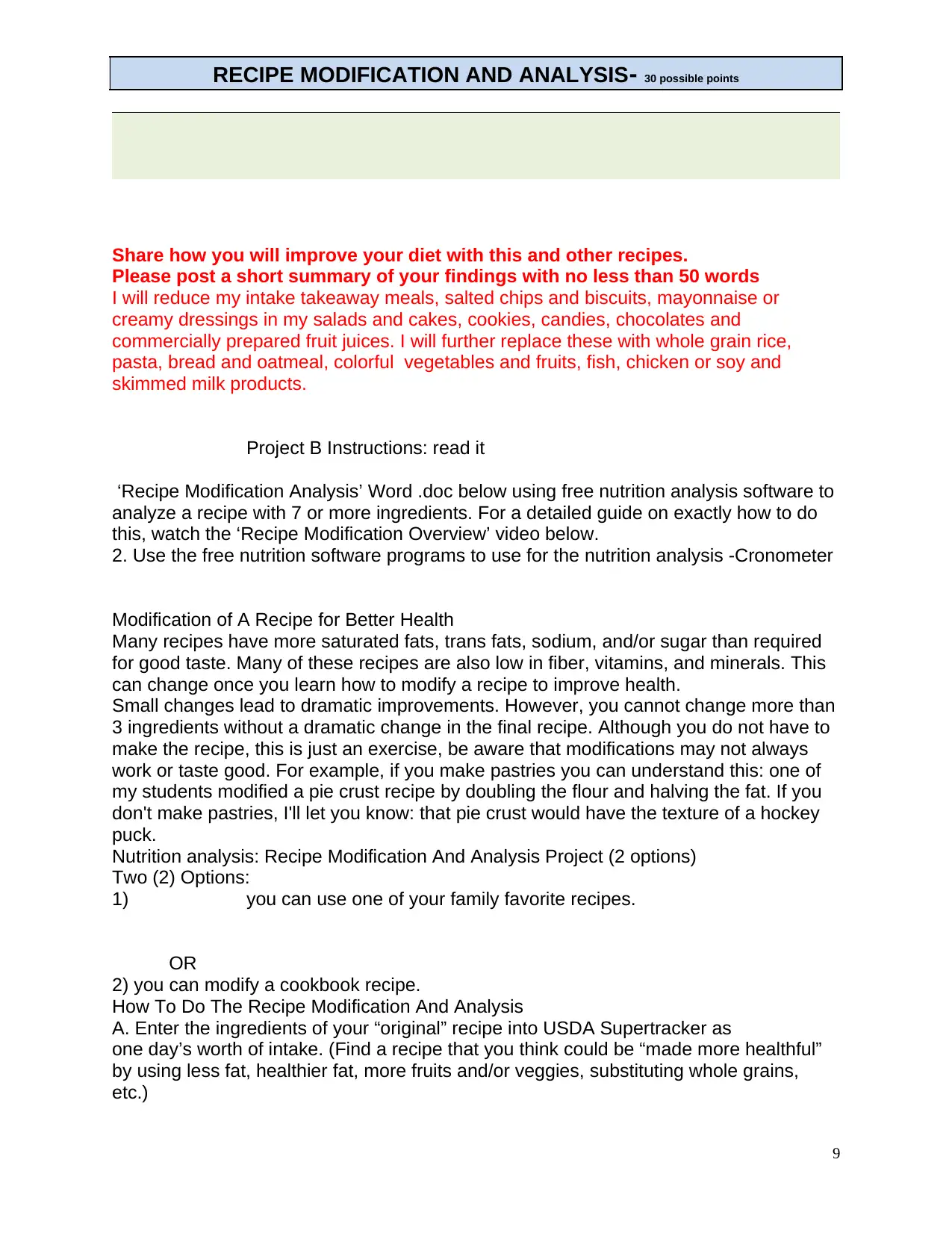
RECIPE MODIFICATION AND ANALYSIS- 30 possible points
Share how you will improve your diet with this and other recipes.
Please post a short summary of your findings with no less than 50 words
I will reduce my intake takeaway meals, salted chips and biscuits, mayonnaise or
creamy dressings in my salads and cakes, cookies, candies, chocolates and
commercially prepared fruit juices. I will further replace these with whole grain rice,
pasta, bread and oatmeal, colorful vegetables and fruits, fish, chicken or soy and
skimmed milk products.
Project B Instructions: read it
‘Recipe Modification Analysis’ Word .doc below using free nutrition analysis software to
analyze a recipe with 7 or more ingredients. For a detailed guide on exactly how to do
this, watch the ‘Recipe Modification Overview’ video below.
2. Use the free nutrition software programs to use for the nutrition analysis -Cronometer
Modification of A Recipe for Better Health
Many recipes have more saturated fats, trans fats, sodium, and/or sugar than required
for good taste. Many of these recipes are also low in fiber, vitamins, and minerals. This
can change once you learn how to modify a recipe to improve health.
Small changes lead to dramatic improvements. However, you cannot change more than
3 ingredients without a dramatic change in the final recipe. Although you do not have to
make the recipe, this is just an exercise, be aware that modifications may not always
work or taste good. For example, if you make pastries you can understand this: one of
my students modified a pie crust recipe by doubling the flour and halving the fat. If you
don't make pastries, I'll let you know: that pie crust would have the texture of a hockey
puck.
Nutrition analysis: Recipe Modification And Analysis Project (2 options)
Two (2) Options:
1) you can use one of your family favorite recipes.
OR
2) you can modify a cookbook recipe.
How To Do The Recipe Modification And Analysis
A. Enter the ingredients of your “original” recipe into USDA Supertracker as
one day’s worth of intake. (Find a recipe that you think could be “made more healthful”
by using less fat, healthier fat, more fruits and/or veggies, substituting whole grains,
etc.)
9
Share how you will improve your diet with this and other recipes.
Please post a short summary of your findings with no less than 50 words
I will reduce my intake takeaway meals, salted chips and biscuits, mayonnaise or
creamy dressings in my salads and cakes, cookies, candies, chocolates and
commercially prepared fruit juices. I will further replace these with whole grain rice,
pasta, bread and oatmeal, colorful vegetables and fruits, fish, chicken or soy and
skimmed milk products.
Project B Instructions: read it
‘Recipe Modification Analysis’ Word .doc below using free nutrition analysis software to
analyze a recipe with 7 or more ingredients. For a detailed guide on exactly how to do
this, watch the ‘Recipe Modification Overview’ video below.
2. Use the free nutrition software programs to use for the nutrition analysis -Cronometer
Modification of A Recipe for Better Health
Many recipes have more saturated fats, trans fats, sodium, and/or sugar than required
for good taste. Many of these recipes are also low in fiber, vitamins, and minerals. This
can change once you learn how to modify a recipe to improve health.
Small changes lead to dramatic improvements. However, you cannot change more than
3 ingredients without a dramatic change in the final recipe. Although you do not have to
make the recipe, this is just an exercise, be aware that modifications may not always
work or taste good. For example, if you make pastries you can understand this: one of
my students modified a pie crust recipe by doubling the flour and halving the fat. If you
don't make pastries, I'll let you know: that pie crust would have the texture of a hockey
puck.
Nutrition analysis: Recipe Modification And Analysis Project (2 options)
Two (2) Options:
1) you can use one of your family favorite recipes.
OR
2) you can modify a cookbook recipe.
How To Do The Recipe Modification And Analysis
A. Enter the ingredients of your “original” recipe into USDA Supertracker as
one day’s worth of intake. (Find a recipe that you think could be “made more healthful”
by using less fat, healthier fat, more fruits and/or veggies, substituting whole grains,
etc.)
9
⊘ This is a preview!⊘
Do you want full access?
Subscribe today to unlock all pages.

Trusted by 1+ million students worldwide
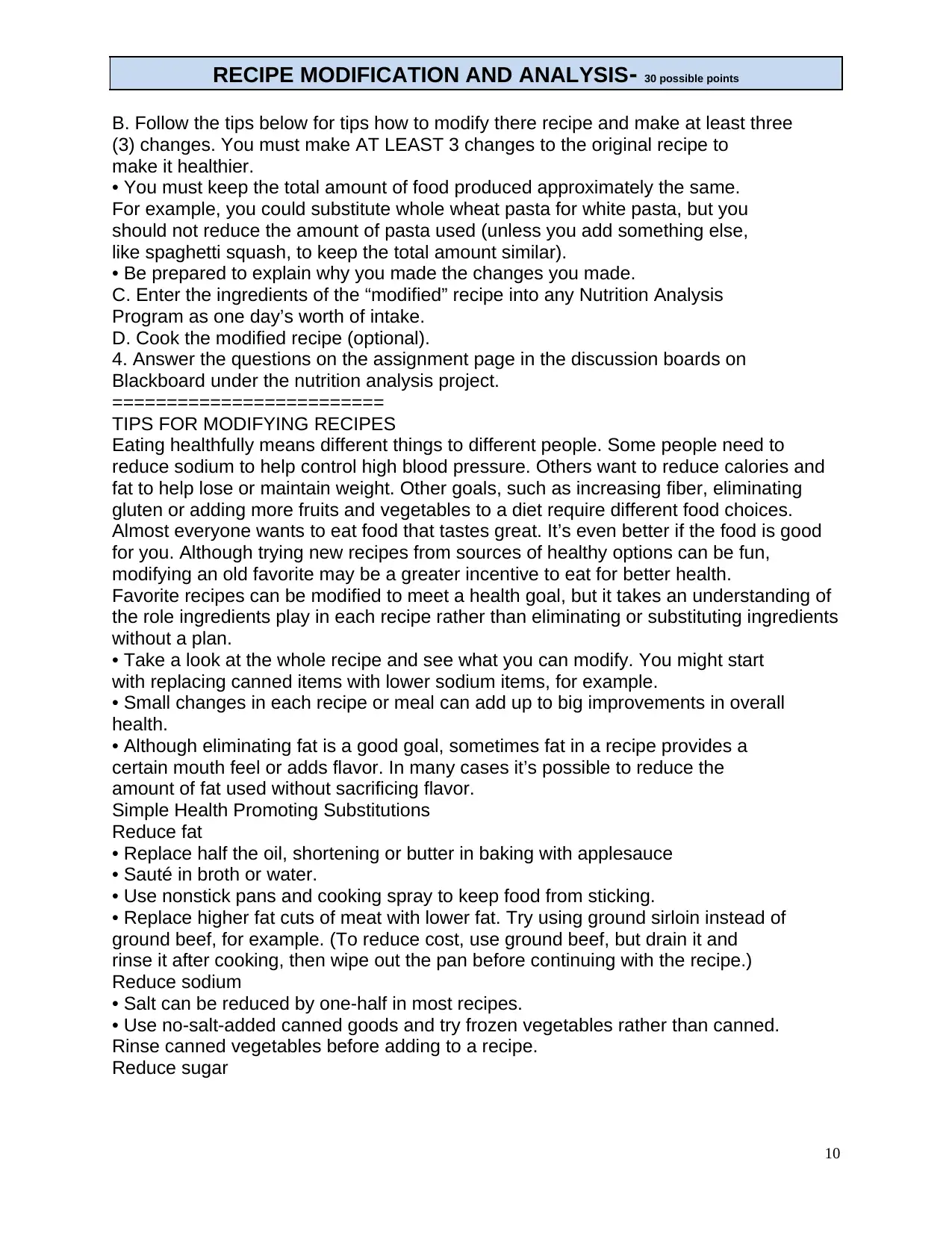
RECIPE MODIFICATION AND ANALYSIS- 30 possible points
B. Follow the tips below for tips how to modify there recipe and make at least three
(3) changes. You must make AT LEAST 3 changes to the original recipe to
make it healthier.
• You must keep the total amount of food produced approximately the same.
For example, you could substitute whole wheat pasta for white pasta, but you
should not reduce the amount of pasta used (unless you add something else,
like spaghetti squash, to keep the total amount similar).
• Be prepared to explain why you made the changes you made.
C. Enter the ingredients of the “modified” recipe into any Nutrition Analysis
Program as one day’s worth of intake.
D. Cook the modified recipe (optional).
4. Answer the questions on the assignment page in the discussion boards on
Blackboard under the nutrition analysis project.
=========================
TIPS FOR MODIFYING RECIPES
Eating healthfully means different things to different people. Some people need to
reduce sodium to help control high blood pressure. Others want to reduce calories and
fat to help lose or maintain weight. Other goals, such as increasing fiber, eliminating
gluten or adding more fruits and vegetables to a diet require different food choices.
Almost everyone wants to eat food that tastes great. It’s even better if the food is good
for you. Although trying new recipes from sources of healthy options can be fun,
modifying an old favorite may be a greater incentive to eat for better health.
Favorite recipes can be modified to meet a health goal, but it takes an understanding of
the role ingredients play in each recipe rather than eliminating or substituting ingredients
without a plan.
• Take a look at the whole recipe and see what you can modify. You might start
with replacing canned items with lower sodium items, for example.
• Small changes in each recipe or meal can add up to big improvements in overall
health.
• Although eliminating fat is a good goal, sometimes fat in a recipe provides a
certain mouth feel or adds flavor. In many cases it’s possible to reduce the
amount of fat used without sacrificing flavor.
Simple Health Promoting Substitutions
Reduce fat
• Replace half the oil, shortening or butter in baking with applesauce
• Sauté in broth or water.
• Use nonstick pans and cooking spray to keep food from sticking.
• Replace higher fat cuts of meat with lower fat. Try using ground sirloin instead of
ground beef, for example. (To reduce cost, use ground beef, but drain it and
rinse it after cooking, then wipe out the pan before continuing with the recipe.)
Reduce sodium
• Salt can be reduced by one-half in most recipes.
• Use no-salt-added canned goods and try frozen vegetables rather than canned.
Rinse canned vegetables before adding to a recipe.
Reduce sugar
10
B. Follow the tips below for tips how to modify there recipe and make at least three
(3) changes. You must make AT LEAST 3 changes to the original recipe to
make it healthier.
• You must keep the total amount of food produced approximately the same.
For example, you could substitute whole wheat pasta for white pasta, but you
should not reduce the amount of pasta used (unless you add something else,
like spaghetti squash, to keep the total amount similar).
• Be prepared to explain why you made the changes you made.
C. Enter the ingredients of the “modified” recipe into any Nutrition Analysis
Program as one day’s worth of intake.
D. Cook the modified recipe (optional).
4. Answer the questions on the assignment page in the discussion boards on
Blackboard under the nutrition analysis project.
=========================
TIPS FOR MODIFYING RECIPES
Eating healthfully means different things to different people. Some people need to
reduce sodium to help control high blood pressure. Others want to reduce calories and
fat to help lose or maintain weight. Other goals, such as increasing fiber, eliminating
gluten or adding more fruits and vegetables to a diet require different food choices.
Almost everyone wants to eat food that tastes great. It’s even better if the food is good
for you. Although trying new recipes from sources of healthy options can be fun,
modifying an old favorite may be a greater incentive to eat for better health.
Favorite recipes can be modified to meet a health goal, but it takes an understanding of
the role ingredients play in each recipe rather than eliminating or substituting ingredients
without a plan.
• Take a look at the whole recipe and see what you can modify. You might start
with replacing canned items with lower sodium items, for example.
• Small changes in each recipe or meal can add up to big improvements in overall
health.
• Although eliminating fat is a good goal, sometimes fat in a recipe provides a
certain mouth feel or adds flavor. In many cases it’s possible to reduce the
amount of fat used without sacrificing flavor.
Simple Health Promoting Substitutions
Reduce fat
• Replace half the oil, shortening or butter in baking with applesauce
• Sauté in broth or water.
• Use nonstick pans and cooking spray to keep food from sticking.
• Replace higher fat cuts of meat with lower fat. Try using ground sirloin instead of
ground beef, for example. (To reduce cost, use ground beef, but drain it and
rinse it after cooking, then wipe out the pan before continuing with the recipe.)
Reduce sodium
• Salt can be reduced by one-half in most recipes.
• Use no-salt-added canned goods and try frozen vegetables rather than canned.
Rinse canned vegetables before adding to a recipe.
Reduce sugar
10
Paraphrase This Document
Need a fresh take? Get an instant paraphrase of this document with our AI Paraphraser
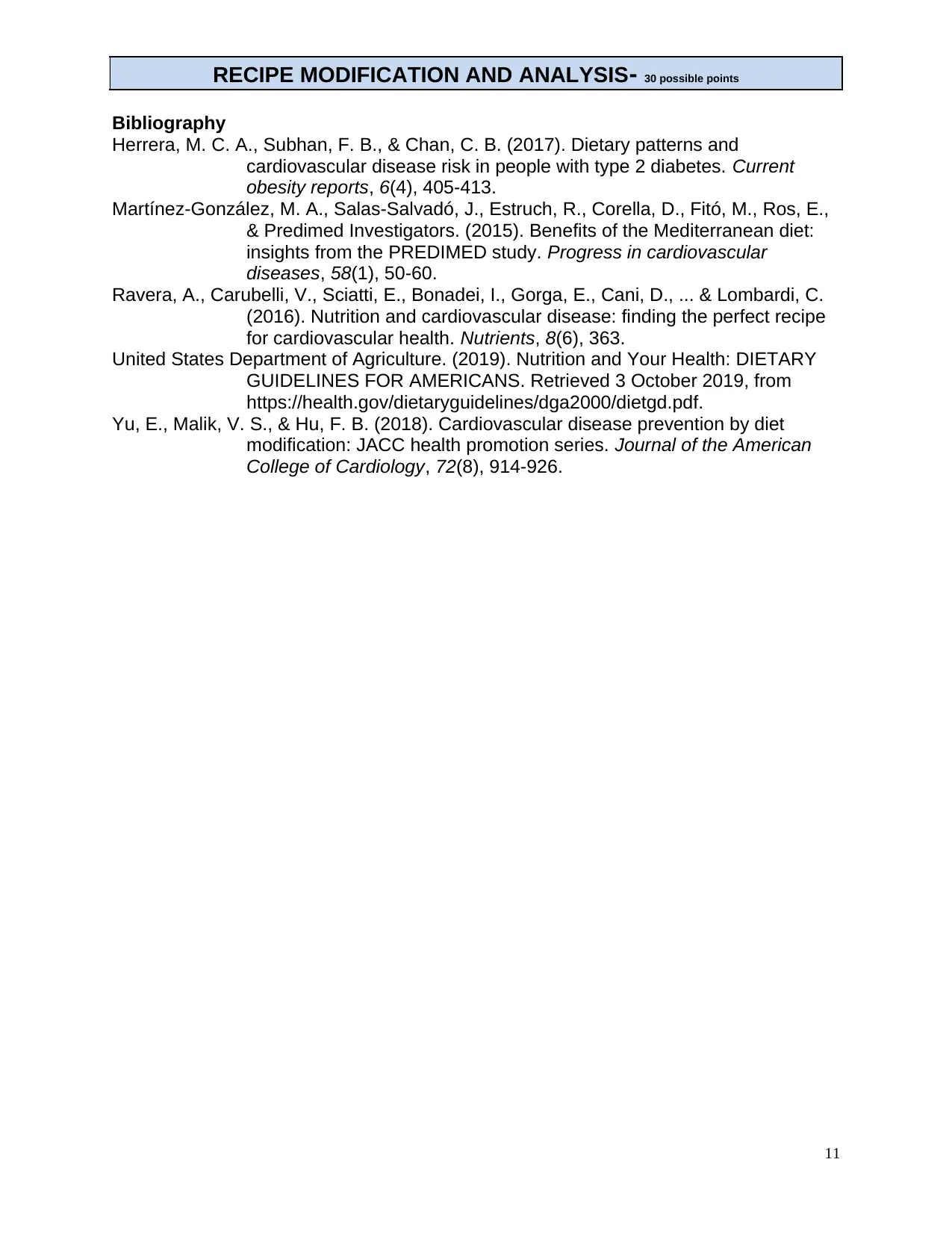
RECIPE MODIFICATION AND ANALYSIS- 30 possible points
Bibliography
Herrera, M. C. A., Subhan, F. B., & Chan, C. B. (2017). Dietary patterns and
cardiovascular disease risk in people with type 2 diabetes. Current
obesity reports, 6(4), 405-413.
Martínez-González, M. A., Salas-Salvadó, J., Estruch, R., Corella, D., Fitó, M., Ros, E.,
& Predimed Investigators. (2015). Benefits of the Mediterranean diet:
insights from the PREDIMED study. Progress in cardiovascular
diseases, 58(1), 50-60.
Ravera, A., Carubelli, V., Sciatti, E., Bonadei, I., Gorga, E., Cani, D., ... & Lombardi, C.
(2016). Nutrition and cardiovascular disease: finding the perfect recipe
for cardiovascular health. Nutrients, 8(6), 363.
United States Department of Agriculture. (2019). Nutrition and Your Health: DIETARY
GUIDELINES FOR AMERICANS. Retrieved 3 October 2019, from
https://health.gov/dietaryguidelines/dga2000/dietgd.pdf.
Yu, E., Malik, V. S., & Hu, F. B. (2018). Cardiovascular disease prevention by diet
modification: JACC health promotion series. Journal of the American
College of Cardiology, 72(8), 914-926.
11
Bibliography
Herrera, M. C. A., Subhan, F. B., & Chan, C. B. (2017). Dietary patterns and
cardiovascular disease risk in people with type 2 diabetes. Current
obesity reports, 6(4), 405-413.
Martínez-González, M. A., Salas-Salvadó, J., Estruch, R., Corella, D., Fitó, M., Ros, E.,
& Predimed Investigators. (2015). Benefits of the Mediterranean diet:
insights from the PREDIMED study. Progress in cardiovascular
diseases, 58(1), 50-60.
Ravera, A., Carubelli, V., Sciatti, E., Bonadei, I., Gorga, E., Cani, D., ... & Lombardi, C.
(2016). Nutrition and cardiovascular disease: finding the perfect recipe
for cardiovascular health. Nutrients, 8(6), 363.
United States Department of Agriculture. (2019). Nutrition and Your Health: DIETARY
GUIDELINES FOR AMERICANS. Retrieved 3 October 2019, from
https://health.gov/dietaryguidelines/dga2000/dietgd.pdf.
Yu, E., Malik, V. S., & Hu, F. B. (2018). Cardiovascular disease prevention by diet
modification: JACC health promotion series. Journal of the American
College of Cardiology, 72(8), 914-926.
11
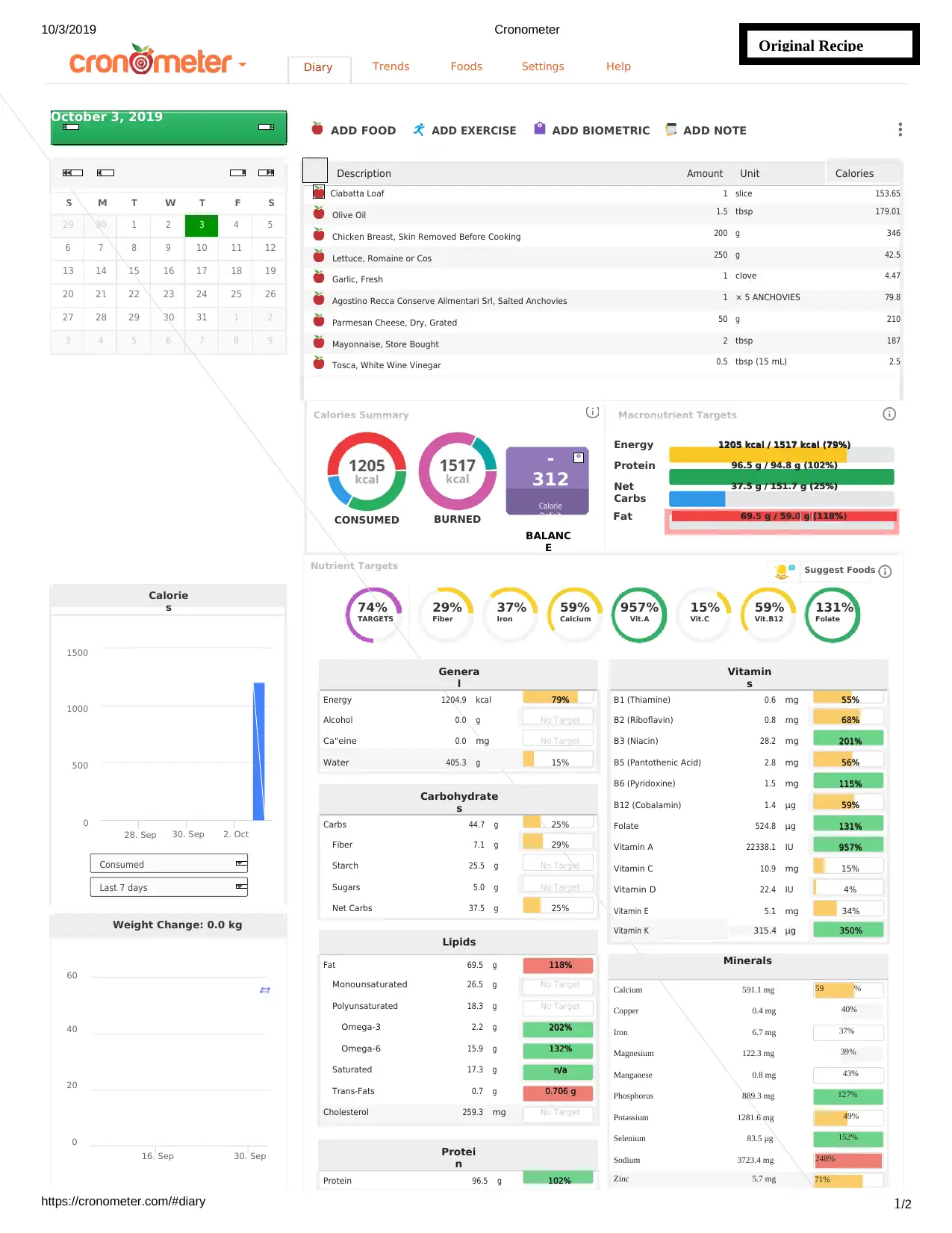
1/2https://cronometer.com/#diary
Cronometer10/3/2019
Oct 2019
S M T W T F S
29 30 1 2 3 4 5
6 7 8 9 10 11 12
13 14 15 16 17 18 19
20 21 22 23 24 25 26
27 28 29 30 31 1 2
3 4 5 6 7 8 9
Description Amount Unit Calories
Ciabatta Loaf 1 slice 153.65
Olive Oil 1.5 tbsp 179.01
Chicken Breast, Skin Removed Before Cooking 200 g 346
Lettuce, Romaine or Cos 250 g 42.5
Garlic, Fresh 1 clove 4.47
Agostino Recca Conserve Alimentari Srl, Salted Anchovies 1 × 5 ANCHOVIES 79.8
Parmesan Cheese, Dry, Grated 50 g 210
Mayonnaise, Store Bought 2 tbsp 187
Tosca, White Wine Vinegar 0.5 tbsp (15 mL) 2.5
Nutrient Targets Suggest Foods
74%
TARGETS
29%
Fiber
37%
Iron
59%
Calcium
957%
Vit.A
15%
Vit.C
59%
Vit.B12
131%
Folate
71%5.7 mgZinc
3723.4 mgSodium
83.5 μgSelenium
1281.6 mgPotassium
889.3 mgPhosphorus
0.8 mgManganese
122.3 mgMagnesium
6.7 mgIron
0.4 mgCopper
591.1 mgCalcium
Minerals
9%4
43%
39%
37%
40%
%59
248%
152%
127%
October 3, 2019
Diary Trends Foods Settings Help
ADD FOOD ADD EXERCISE ADD BIOMETRIC ADD NOTE
Calories Summary
CONSUMED BURNED
-
312
Calorie
Deficit
BALANC
E
Macronutrient Targets
Energy 12051205 kcalkcal // 15171517 kcalkcal (79%)(79%)
Protein 96.596.5 gg // 94.894.8 gg (102%)(102%)
Net
Carbs
37.537.5 gg // 151.7151.7 gg (25%)(25%)
Fat 69.69.5 gg // 59.59.0 gg (118%(118%)
Calorie
s
1500
28. Sep
Consumed
Last 7 days
1000
500
0
30. Sep 2. Oct
Genera
l
Energy 1204.9 kcal 79%79%
Alcohol 0.0 g No Target
Ca"eine 0.0 mg No Target
Water 405.3 g 15%
Vitamin
s
B1 (Thiamine) 0.6 mg 55%55%
B2 (Riboflavin) 0.8 mg 68%68%
B3 (Niacin) 28.2 mg 201%201%
B5 (Pantothenic Acid) 2.8 mg 56%56%
B6 (Pyridoxine) 1.5 mg 115%115%
B12 (Cobalamin) 1.4 μg 59%59%
Folate 524.8 μg 131%131%
Vitamin A 22338.1 IU 957%957%
Vitamin C 10.9 mg 15%
Vitamin D 22.4 IU 4%
Vitamin E
Vitamin K
5.1
315.4
mg
μg
34%
350%350%
Carbohydrate
s
Carbs 44.7 g 25%
Fiber 7.1 g 29%
Starch 25.5 g No Target
Sugars 5.0 g No Target
Net Carbs 37.5 g 25%
Lipids
Fat 69.5 g 118%118%
Monounsaturated 26.5 g No Target
Polyunsaturated 18.3 g No Target
Omega-3 2.2 g 202%202%
Omega-6 15.9 g 132%132%
Saturated 17.3 g n/an/a
Trans-Fats 0.7 g 0.7060.706 gg
Cholesterol 259.3 mg No Target
Weight Change: 0.0 kg
60
40
20
0
16. Sep 30. Sep Protei
n
Protein 96.5 g 102%102%
Original Recipe
Cronometer10/3/2019
Oct 2019
S M T W T F S
29 30 1 2 3 4 5
6 7 8 9 10 11 12
13 14 15 16 17 18 19
20 21 22 23 24 25 26
27 28 29 30 31 1 2
3 4 5 6 7 8 9
Description Amount Unit Calories
Ciabatta Loaf 1 slice 153.65
Olive Oil 1.5 tbsp 179.01
Chicken Breast, Skin Removed Before Cooking 200 g 346
Lettuce, Romaine or Cos 250 g 42.5
Garlic, Fresh 1 clove 4.47
Agostino Recca Conserve Alimentari Srl, Salted Anchovies 1 × 5 ANCHOVIES 79.8
Parmesan Cheese, Dry, Grated 50 g 210
Mayonnaise, Store Bought 2 tbsp 187
Tosca, White Wine Vinegar 0.5 tbsp (15 mL) 2.5
Nutrient Targets Suggest Foods
74%
TARGETS
29%
Fiber
37%
Iron
59%
Calcium
957%
Vit.A
15%
Vit.C
59%
Vit.B12
131%
Folate
71%5.7 mgZinc
3723.4 mgSodium
83.5 μgSelenium
1281.6 mgPotassium
889.3 mgPhosphorus
0.8 mgManganese
122.3 mgMagnesium
6.7 mgIron
0.4 mgCopper
591.1 mgCalcium
Minerals
9%4
43%
39%
37%
40%
%59
248%
152%
127%
October 3, 2019
Diary Trends Foods Settings Help
ADD FOOD ADD EXERCISE ADD BIOMETRIC ADD NOTE
Calories Summary
CONSUMED BURNED
-
312
Calorie
Deficit
BALANC
E
Macronutrient Targets
Energy 12051205 kcalkcal // 15171517 kcalkcal (79%)(79%)
Protein 96.596.5 gg // 94.894.8 gg (102%)(102%)
Net
Carbs
37.537.5 gg // 151.7151.7 gg (25%)(25%)
Fat 69.69.5 gg // 59.59.0 gg (118%(118%)
Calorie
s
1500
28. Sep
Consumed
Last 7 days
1000
500
0
30. Sep 2. Oct
Genera
l
Energy 1204.9 kcal 79%79%
Alcohol 0.0 g No Target
Ca"eine 0.0 mg No Target
Water 405.3 g 15%
Vitamin
s
B1 (Thiamine) 0.6 mg 55%55%
B2 (Riboflavin) 0.8 mg 68%68%
B3 (Niacin) 28.2 mg 201%201%
B5 (Pantothenic Acid) 2.8 mg 56%56%
B6 (Pyridoxine) 1.5 mg 115%115%
B12 (Cobalamin) 1.4 μg 59%59%
Folate 524.8 μg 131%131%
Vitamin A 22338.1 IU 957%957%
Vitamin C 10.9 mg 15%
Vitamin D 22.4 IU 4%
Vitamin E
Vitamin K
5.1
315.4
mg
μg
34%
350%350%
Carbohydrate
s
Carbs 44.7 g 25%
Fiber 7.1 g 29%
Starch 25.5 g No Target
Sugars 5.0 g No Target
Net Carbs 37.5 g 25%
Lipids
Fat 69.5 g 118%118%
Monounsaturated 26.5 g No Target
Polyunsaturated 18.3 g No Target
Omega-3 2.2 g 202%202%
Omega-6 15.9 g 132%132%
Saturated 17.3 g n/an/a
Trans-Fats 0.7 g 0.7060.706 gg
Cholesterol 259.3 mg No Target
Weight Change: 0.0 kg
60
40
20
0
16. Sep 30. Sep Protei
n
Protein 96.5 g 102%102%
Original Recipe
⊘ This is a preview!⊘
Do you want full access?
Subscribe today to unlock all pages.

Trusted by 1+ million students worldwide
1 out of 16
Related Documents
Your All-in-One AI-Powered Toolkit for Academic Success.
+13062052269
info@desklib.com
Available 24*7 on WhatsApp / Email
![[object Object]](/_next/static/media/star-bottom.7253800d.svg)
Unlock your academic potential
Copyright © 2020–2025 A2Z Services. All Rights Reserved. Developed and managed by ZUCOL.

